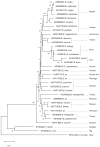Exploring Eimeria Genomes to Understand Population Biology: Recent Progress and Future Opportunities
- PMID: 32967167
- PMCID: PMC7564333
- DOI: 10.3390/genes11091103
Exploring Eimeria Genomes to Understand Population Biology: Recent Progress and Future Opportunities
Abstract
Eimeria, protozoan parasites from the phylum Apicomplexa, can cause the enteric disease coccidiosis in all farmed animals. Coccidiosis is commonly considered to be most significant in poultry; due in part to the vast number of chickens produced in the World each year, their short generation time, and the narrow profit margins associated with their production. Control of Eimeria has long been dominated by routine chemoprophylaxis, but has been supplemented or replaced by live parasite vaccination in a minority of production sectors. However, public and legislative demands for reduced drug use in food production is now driving dramatic change, replacing reliance on relatively indiscriminate anticoccidial drugs with vaccines that are Eimeria species-, and in some examples, strain-specific. Unfortunately, the consequences of deleterious selection on Eimeria population structure and genome evolution incurred by exposure to anticoccidial drugs or vaccines are unclear. Genome sequence assemblies were published in 2014 for all seven Eimeria species that infect chickens, stimulating the first population genetics studies for these economically important parasites. Here, we review current knowledge of eimerian genomes and highlight challenges posed by the discovery of new, genetically cryptic Eimeria operational taxonomic units (OTUs) circulating in chicken populations. As sequencing technologies evolve understanding of eimerian genomes will improve, with notable utility for studies of Eimeria biology, diversity and opportunities for control.
Keywords: Eimeria; chickens; genetics; genome; population structure.
Conflict of interest statement
The authors declare no conflict of interest. The sponsors had no role in the design, execution, interpretation, or writing of the study.
Figures

References
-
- Dubey J.P. Coccidiosis in Livestock, Poultry, Companion Animals, and Humans. CRC Press, Taylor & Francis Group; Boca Raton, FL, USA: 2020.
-
- Wiedmer S., Erdbeer A., Volke B., Randel S., Kapplusch F., Hanig S., Kurth M. Identification and analysis of Eimeria nieschulzi gametocyte genes reveal splicing events of gam genes and conserved motifs in the wall-forming proteins within the genus Eimeria (coccidia, apicomplexa) Parasite. 2017;24:50. doi: 10.1051/parasite/2017049. - DOI - PMC - PubMed
Publication types
MeSH terms
Substances
Grants and funding
LinkOut - more resources
Full Text Sources
Research Materials

